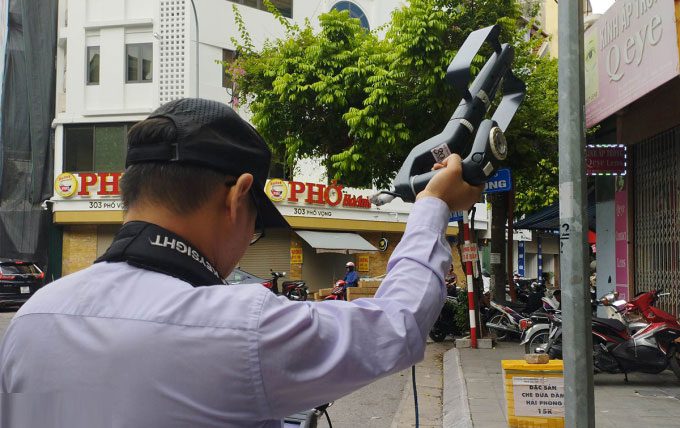A series of cars and motorcycles on Vong Street have been unable to unlock their smart keys due to interference from a high-power radio frequency device, causing connection loss.
The situation where cars and motorcycles suddenly cannot unlock their smart keys in the intersection area of Nguyen An Ninh – Vong Street over the past few days is not unusual. Using a testing device, authorities discovered a remote-controlled radio frequency device used to turn a water pump on and off at a household on Vong Street is the source of interference that is disabling the smart keys of motorcycles and cars.
Explaining this issue, Dr. Truong Trung Kien, a graduate in electronics from the University of Texas (USA), stated that radio waves require bandwidth with a specific frequency to connect two devices. For electronic devices such as smart keys for motorcycles or cars, the frequency width and transmission channel are very narrow. When another device emits a strong signal at a close distance on the same frequency, it can cause wave interference, resulting in a loss of connection.
According to him, not only car smart keys but also other control devices, such as rolling shutters, which use “amateur” bands (illegally used without permission) controlled by radio waves in the vicinity can also be interfered with. These devices often emit high power to be easily controlled from a distance but occupy a bandwidth that many users share, causing interference with other devices.
For a device using standard radio waves, Dr. Kien explained that manufacturers must register with the relevant authorities, specifically the Ministry of Information and Communications, to obtain an operating frequency and specify the maximum transmission power. Because if devices operate on the same frequency but within the permissible power limits, they should not affect surrounding devices.

Officials from the Radio Frequency Department using testing equipment on Vong Street, June 22. (Photo: Viet An).
Dr. Hoang Ngoc Tan, Head of the Automotive Engineering Department at Lac Hong University, explained that the interference mechanism involves the device creating a “wall” that prevents communication between the transmission and reception components of the surrounding radio-controlled devices. This communication uses a fixed frequency, mostly in the short frequency range. When there is a device causing interference, the transmission part still operates, but the reception part cannot receive the signal.
According to Mr. Tan, the smart key unlocking devices for motorcycles and cars usually have anti-interference components integrated into their circuits. However, since the purpose of the smart key is to operate within a close range, manufacturers often focus less on this aspect. They prioritize security and anti-theft features for vehicles. If anti-interference technology were to be integrated at a higher level, the costs would increase.
Experts agree that the incident regarding the remote-controlled water pump causing interference in Hanoi is likely due to the homeowner inadvertently purchasing a smuggled device that lacks a compliance testing label, thus affecting other devices. Besides interference issues, experts believe that using high-power radio wave transmission devices could impact health, as electromagnetic waves can affect the brain and other body parts.
To handle situations when the smart key loses connection due to wave interference, according to Mr. Ngo Dang Luu, an electrical and electronics expert and Director of Anh Minh Global Company, when a car cannot be unlocked, the owner should try to set an alert by pressing the lock button on the remote control or using a physical key. This helps the owner detect interference and ensure the vehicle’s safety. Additionally, when experiencing interference, the owner can try moving closer to the vehicle and attempt to unlock it again. Being at a closer distance may help strengthen the signal transmitted to the locking system and overcome the interference.





















































